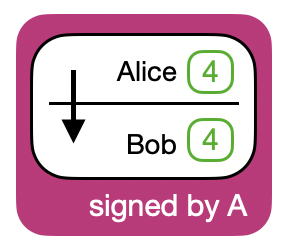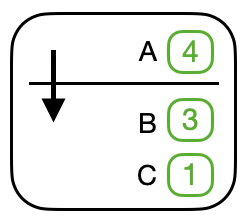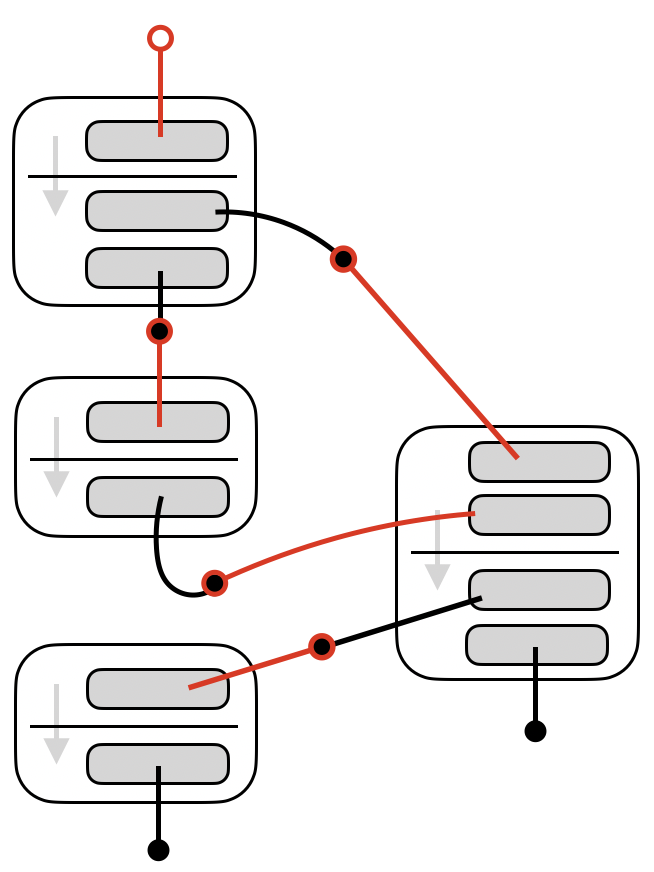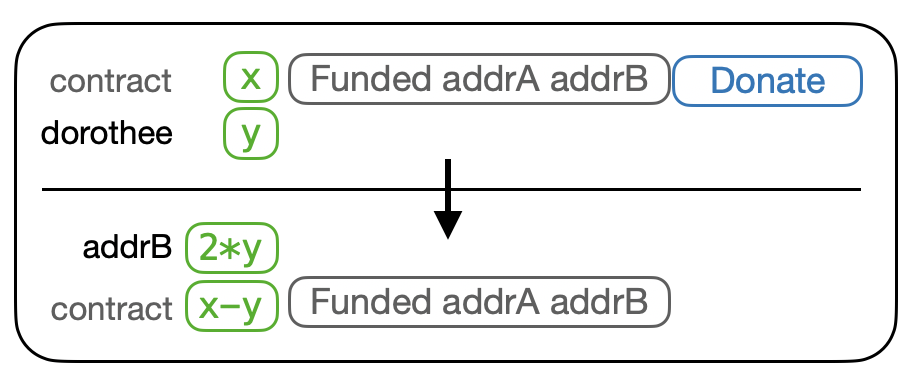Introduction to the Cardano blockchain ledger and smart contracts
Table of contents
Recently, I wanted to better understand how the Cardano blockchain works on a technical level, in particular how the ledger and smart contracts work. Cardano is a rapidly moving target, and I had some trouble finding an accessible, yet detailed introduction. So, I decided to write up an introduction myself, after browsing through the documentation for Cardano, the (separate?) documentation for Plutus, the research papers, and the formal specifications. For me, the most accessible summary was M. Chakravarty et. al.’s paper “Functional Blockchain Contracts”, though for some reason, this paper still has draft status.
Cardano is a decentralized blockchain platform built on a proof-of-stake consensus mechanism. The main cryptocurrency on the Cardano blockchain is called ADA, named after lady Ada Lovelace.
Cardano is developed by the Cardano Foundation. You can find more information about their goals and ecosystem on their website. In this post, I would like to focus on the technology and give a brief, yet accessible introduction to how the Cardano ledger works, i.e. how transactions and smart contracts work. For more insight into the consensus protocol that is used to add transactions to the blockchain in real time, I refer to a blogpost by E. de Vries.
The Cardano Ledger
Basic transactions
This section presents the information you need to make sense of basic transactions on the blockchain, which you can view with e.g. the Cardano explorer.
A blockchain is a decentralized ledger. This ledger records transactions between different parties. A simple example of such a transaction is one where Alice (A) sends some quantity of digital currency to Bob (B). In the Cardano blockchain, this digital currency is called ADA. The following figure illustrates a transfer of four ADA from Alice to Bob:

The illustration shows the state before the transaction above the horizontal line, and the state after the transaction below the line: Before, Alice owns 4 ADA, while afterwards, Bob owns 4 ADA.
Unlike in the traditional banking system, where the bank authorizes who can submit transactions, anybody can submit a transaction to the blockchain. However, we have to make sure that only Alice is authorized to add this transaction to the ledger; otherwise, the system becomes useless, as e.g. Bob could attempt to add this transactions for his own benefit without confirmation from Alice. In a blockchain, this authorization is done using public key cryptography: Alice has a private key, which she uses to digitally sign the contents of the transaction. Using Alice’s public key, anyone can verify that it was indeed Alice who signed the transaction, but only someone who knows the private key is able to produce this signature. Typically, Alice uses a wallet software to manage her private key and sign transactions. The following figure illustrates the signed transaction:

If we know Alice’s public key, we can check that the signature is valid and that it was indeed Alice who authorized the transaction. In fact, the blockchain does not keep track of which key belongs to whom; Alice’s public key is simply included in the transaction data. Nothing prevents Alice from using multiple public and private key pairs, corresponding to different “accounts” or “wallets”.
The flip side of not relying on a bank to authorize transactions, and possibly revert them in the case of abuse, is that the security of your money is tied to the security of your private key. Specifically, a) you need to keep your private key secret, because other people can spend your money if they know it, and b) if you lose / forget / hide too well your private key, nobody, including you, can spend your money anymore. It cannot be stressed often enough: Your private key = your money!
In the real Cardano blockchain, parties are not identified by their public keys; instead, money is transferred between addresses. A party can use as many addresses as they like. While the public key of Alice is included in the transaction, the public key of Bob is not included, only one of his addresses. We will explain the relation between keys and addresses in more detail below.
In addition, the Cardano blockchain allows transactions between multiple addresses at once. For instance, a transaction may transfer money from one address to, say, two different addresses. The following figure illustrates a transfer of four ADA from address A, three of which go to address B, and one of which goes to address C:

The Cardano blockchain is public. Anyone can view the transactions on the Cardano explorer. For example, the transaction with ID 825c63… takes 42.42… ADA from an address and transfers 5 ADA to one address and 37.25… to another. In addition, 0.16… ADA is taken as a fee for including the transaction in the blockchain.
It is worth noting that the Cardano ledger does not record total balances of money owned by different addresses. It turns out that this simplifies the ledger model; we will discuss this below. Here, we merely note that storing total balances is not necessary, because the blockchain is public information, and one can compute the address balance by following all transactions from the beginning. The Cardano explorer does that automatically; for example, at the time of this writing, the address addr1q8kzwv… was involved in two transactions and has a total balance of 0 ADA.
On the Cardano blockchain, transactions are grouped into blocks, and blocks are grouped into epochs. This is relevant for determining which of the submitted transactions are to be included in the ledger, via the proof-of-stake consensus protocol, but as far as the currency is concerned, the grouping is irrelevant.
UTXO
While the previous section explained how to read basic transactions on the Cardano blockchain explorer, this section will present more details on how transactions are constructed. For example, many transaction which represent a simple transfer of currency between two parties are built using three addresses, one input and two output addresses, and sometimes even many more addresses. The reason is that Cardano uses an unspent transaction output (UTXO) model, similar to Bitcoin, which we will explain here.
On the surface, transactions in the unspent transaction output (UTXO) model may look like transfers of funds (money) between addresses, as described previously. However, on a deeper level, the UTXO model is better understood if we take a radical departure from the idea that addresses act as containers for funds. Instead, in the UTXO model, the containers for funds are the transaction outputs. Each transaction consists of a unique transaction ID, a set of inputs, and a list of outputs. Conversely, each output is uniquely identified by its position in the list of outputs and the transaction ID of the associated transaction. The inputs of a new transaction that is added to the blockchain are always references to previous outputs; moreover, once an output has been used as an input to a new transaction, it cannot be used a second time. Put differently, the inputs of new transaction may only refer to unspent transactions, which have not been used as input to another transaction yet. The fact that outputs are associated with addresses and funds is not relevant for being able to connect the inputs and outputs of transactions. The following figure illustrates the blockchain as a set of transactions with connected inputs and outputs

Here, the grey boxes within each figure correspond to inputs (above the line) and outputs (below the line). Each output can be connected to exactly one input; this is visualized by a dangling black line (output) which connects to a dangling red line (input).
The Cardano explorer is not a direct visualization of the UTXO model, because it does not directly show which transaction IDs the inputs reference. However, one can often infer this information from the addresses and funds associated with the input. For example, the address addr1q8kzwv… is involved in two transactions. The last output of the first transaction 34d8… is the input to the second transaction 825c…, because both the address and the amount of ADA are identical.
Funds and addresses do become important when validating transactions. For example, a transaction must conserve funds: The sum of funds of the inputs must be equal to the sum of funds of the outputs (minus a small transaction fee). We will discuss this in the next section.
Transferring funds between parties within the UTXO model often involves multiple inputs and outputs. For example, consider an unspent transaction output which contains 5 ADA. Any transaction that wants to use this output must use the entire sum. If we want to transfer 4 ADA to another party, we cannot do this with a transaction that expects 4 ADA as an input — we would not be able to connect it to the output, because an input and an output must match identically. However, we can create a transaction which takes an input with 5 ADA and transfers 4 ADA to one output with an address belonging to the other party, and 1 ADA to a second output with an address that is under our control. Many transactions on the Cardano blockchain are of this kind, for example the transaction 825c63…. However, it may also happen that we want to transfer 4 ADA, but only three outputs with 1.5 Ada each are available that are owned by us. In this case, we create a transactions with these three inputs and with two outputs, one that sends 3 Ada to the other party, and one with the remaining 0.5 Ada and an address owned by us. For example, the transaction 1bab… uses this scheme, as all the inputs have the same address.
This UTXO approach to transferring funds may seem a little roundabout at first, but the advantage is that all validity checks are confined to transactions — we can connect transactions in any way that adheres to the UTXO principle (each output is spent fully and at most once), and be guaranteed that the ledger conserves money as long as each individual transaction is valid. This simplifies the ledger model, and is an example of “compositionality”.
Transaction Validation
Having explained how inputs and outputs are connected via the UTXO model, we next turn to the validation of transactions, which is arguably the most important task of a blockchain. We will look at addresses and public keys for authorizing transactions in this sections, and discuss smart contracts in the next section.
The validation of transactions is what enables blockchain ledgers to store monetary value. To be considered valid, a transaction must pass several checks; only then can it be included in the blockchain ledger.
First, the transaction must conform to the UTXO model, i.e. every input refers to a unique unspent output. This effectively prevents double spending of funds.
Second, money must be conserved. The funds associated to the inputs may be redistributed and be assigned differently to the outputs, but the sum of funds of the inputs must be equal to the sum of funds of the outputs, minus a small transaction fee.
Third, the transaction must be authorized by the parties that own the addresses associated to the inputs. As mentioned in a previous section, this is done using public key cryptography. However, an address is not a public key, instead, it is the hash of a public key. This is a neat trick to reduce the size of the addresses. That said, it is impossible to check a signature by using just the hash of the public key. Thus, the transaction explicitly lists all the public keys that hash to the input addresses, thereby revealing the public keys. The transaction must be signed by all corresponding private keys (which must be kept secret by the parties). However, the public keys of the output addresses are not revealed; this saves space, and adds an extra layer of cryptographic protection by not exposing the public keys to a possible (though likely hopeless) offline cryptanalysis.
With these validation checks, the ledger is suitable for storing monetary value.
However, by allowing more complicated validation logic, we can support smart contracts, which are automated contracts for transferring funds and data. To this end, the Cardano ledger associates inputs and outputs not just with funds and addresses, but with additional, custom data which encodes the state of the smart contract. This leads to the Extended UTXO (EUTXO) model, which we discuss in the next section.
At the time of this writing, the data supported by the Cardano ledger, and also its data format, are not set in stone: From time to time, the Cardano blockchain will undergo a hard fork where the ledger format changes. However, thanks to a special programming technique known as a hard fork combinator, these forks are almost seamless: existing transactions on the ledger will be unchanged, and are compatible with all future transactions that are added to the chain. The Cardano ledger has already undergone a number of hard forks; the data formats are documented in formal specifications. The Cardano blockchain started with the Byron format, which supported UTXO model transactions of Ada. Then came the Shelly format, which enabled stake pools and staking rewards. The Mary hard fork enabled multi-assets (Shelly-MA), i.e. the transfer of tokens or currencies besides Ada. The Alonzo hard fork will enable smart contracts.
Smart Contracts and EUTXO
Blockchains can automate not just simple transfers of money, but also more complex exchanges involving multiple parties and conditions. Smart contracts are pieces of software that describe such exchanges.
On the Cardano blockchain, smart contracts are identified by their addresses. Instead of sending funds to an address controlled by a human, you can send funds to an address representing a smart contract, which will then perform some automated transactions involving your funds. By looking at the source code for this contract beforehand, you can understand exactly what the contract is going to do. The validity checks on the blockchain ensure that the contract is executed exactly as specified.
A simple example of an exchange suitable for a smart contract would be donation matching: Whenever Bob receives a donation, Alice wants to match that donation with an equal amount of money. One possible implementation in terms of a smart contract would would work as follows: First, Alice sends the funds she wants to use for donation matching to the contract. Then, any willing donor, say Dorothee, sends money to the contract, which will then automatically forward this money plus an equal amount of matching funds to the address owned by Bob.
This example shows that smart contracts often involve multiple transactions: Alice makes a transaction that transfers funds to the contract, and Dorothee makes a transaction that donates to Bob. These transactions need to adhere to the contract rules, e.g. that Alice is the first to make the transaction, and Dorothee must come second. Any smart contract consists of two components: an on-chain component, which ensures that transactions adhere to the contract rules, and an off-chain component, which is a program that Alice or Dorothee use to submit rule-abiding transactions. The on-chain component never submits any transactions to the blockchain, it only checks existing transactions for validity. The on-chain component is run on the nodes that validate the blockchain ledger, while the off-chain component is run by the user, e.g. as part of his wallet. For Cardano, the Plutus platform allows us to write both components using the same programming language, Haskell.
The on-chain component of a smart contract operates like a state machine. When an output of a transaction is a smart contract address, this address has to be accompanied by additional, custom state data. This data represents a new state of the contract. Here, the same hashing trick as for addresses is used: Only a hash of the data, not the data itself is included in the transaction. But when the input of transaction references this output, via the UTXO model, the data is included in full. In addition, this input has to come with additional, custom data called a redeemer, which has the role of user input, and corresponds to a state transition label for the state machine. The UTXO-like ledger model which includes state data and redeemer data is known as the Extended UTXO (EUTXO) model.
For example, the donation matching example above can be implemented with the following state machine:

The machine has a single state Funded addrA addrB, which indicates that the contract is funded and ready to match donations for Bob. This state stores both Alice’s address addrA , and Bob’s address addrB. The possible transitions are Donate for making a matched donation to Bob, and Refund to return Alice’s funds when she wants to end the fundraiser. The state machine may seem somewhat unusual in that the contract state does not contain information about Alice’s total funds, and that the donation amount is not recorded in the Donate transition. However, there is no need for this, because transaction inputs and outputs always store an amount of funds.
The on-chain component can implement this state machine by only accepting the following transaction (schemas) as valid:


Here, the first transaction schema corresponds to a Donate transition. It takes an amount y from Dorothee and transfers twice that amount to Bob, using the funds held by the smart contract input. The second transaction schema corresponds to the Refund transition. It returns all the funds in the contract to Alice by spending the input contract. Here, we have also added an input from Alice (with zero funds) in order to make sure that not only does all the money go to back to Alice, but also that only Alice can initiate a refund: As her address appears in the input, this transaction is only valid with her signature. Similarly, as the smart contract address appears as an input, the validator code of the smart contract is run on this transaction. By refusing all transactions that do not fit into these two schema, only valid transitions of the smart contract state are possible. (The description here is a bit oversimplified in that we have ignored transaction fees and the fact unspent outputs with zero funds are not allowed. Transactions on the blockchain always involve a small fee.)
Finally, to start a fundraiser for Bob, Alice can submit the following transaction to the chain.

This transaction creates a smart contract output with funds, ready to be spent as an input.
Conclusion
We have taken a look at the ledger for the Cardano blockchain. We have looked at basic transactions, the unspent transaction output (UTXO) model popularized by bitcoin, validation with addresses and public keys, and finally introduced the basics of smart contracts and how their on-chain components can be understood as state machines. That said, we have also skipped over some features of the ledger, such as multiple assets and staking, because I believe that they do not affect the substance of the EUTXO model and can be understood separately if desired. I hope this helps!
If this were a YouTube channel, I would ask you to smash the like button and click subscribe. Oh well. I guess I can ask you to leave comments below, though.
